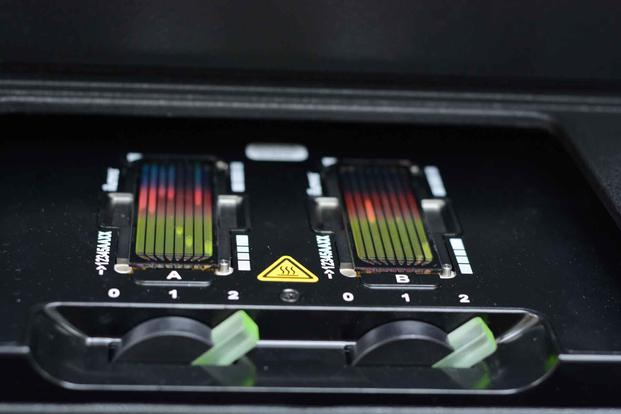Joseph V. Micallef is a best-selling military history and world affairs author, and keynote speaker. Follow him on Twitter @JosephVMicallef.
Genomics refers to an interdisciplinary field of biological science that deals with the structure, evolution, function, mapping and editing of genomes and how the individual genes that comprise the genome interact with each other and with an individual's environment.
A genome is the complete set of an organism's DNA that is expressed across all of its genes. Genomics is the cutting edge of biotechnology today. It offers the possibility of eradicating many congenital disorders and the early identification, if not elimination, of a person's susceptibility to many diseases.
However, it could lead to new bioweapons of mass destruction and the creation of super-soldiers whose enhanced capabilities would give them a marked advantage over other humans.
Genomics and Bioweapons
Biological weapons are nothing new. They've been around since antiquity. In 190 B.C., Hannibal Barca, the Carthaginian general who had been exiled from Carthage following the end of the Second Punic War, found himself in command of Bithynia's fleet during a conflict with Pergamon.
Badly outnumbered by Pergamon's larger navy, Hannibal had his men fling clay jars full of poisonous snakes at the opposing ships. When the jars hit the deck of Pergamon's galleys, they shattered, releasing the snakes. The resulting chaos gave Hannibal an easy victory.
In 1347, during the Mongol siege of Caffa (Feodosiya) in Crimea, a Genoese trading post, the Mongols catapulted the corpses of bubonic plague victims over the city walls. The resulting plague outbreak led to the downfall of the city. Worse, escaping refugees carried bubonic plague into Europe. The Black Death that followed killed between 30% and 60% of Europe's population.
During World War II, Japan's Unit 731 (Manchu Detachment 731) -- headquartered in the Pingfang District of Harbin -- conducted wide-ranging research to identify, produce and test biological weapons. It was the largest of several such units operated by the Japanese Army.
Unit 731 conducted at least 12 large-scale field trials using bubonic plague, cholera, anthrax, typhoid and paratyphoid, among other pathogens. It's estimated that approximately half a million Chinese civilians died as a result of these attacks.
Japan even had a plan to use biological weapons to attack the city of San Diego (code-named Cherry Blossoms at Night) with balloon-borne bombs carrying fleas infected with bubonic plague. The plan would use 15 Aichi M6a Seiran aircraft launched from five I-400 long-range submarines. The attack was set for Sept. 22, 1945, but was called off as a result of the Japanese surrender on Aug. 15.
During the Cold War, the Soviet Union and the United States conducted research into biological weapons. The advent of recombinant DNA technology allowed scientists to develop super pathogens that combined lethal elements of several diseases and were more easily transmissible. These pathogens were referred to as chimeras, after the fire-breathing Greek mythological creature that combined a lion's head, a goat's body and a serpent's tail.
The Biological Weapons Convention, or BWC, of 1975 banned the development, production, acquisition, transfer, stockpiling or use of biological weapons and toxins. The BWC, however, lacks any formal mechanism for verifying compliance. Moreover, it has a broad exemption for research related to biodefense.
The distinction between offensive and defensive bioweapons research is subtle. Even a relatively benign pathogen can become a bioweapon if one party has conferred immunity to its population and an opponent has not.
There are two ways in which genomics impact biological warfare. First, the gene-mapping and editing capabilities of genomics allow scientists to manipulate a pathogen's DNA and determine what particular genes control how it expresses itself. This can lead to a better understanding of how to counter its effects and the medicines needed to do so. It also can facilitate the creation of super pathogens.
Genomics also can be used to anticipate how a virus might mutate and become deadlier. This type of research, called "gain of function," or GOF, is what was being studied at the Wuhan Institute of Virology in Wuhan. It has been suggested that the SARS-CoV-2 virus that causes COVID-19 was the result of a GOF research experiment that escaped the lab.
Weaponizing Genomic Data
There is another way that genomics can be used in biological warfare. The cost of decoding a person's DNA has dropped precipitously over the last two decades. The Human Genome Project, an international scientific research initiative to determine the base pairs that make up human DNA and identify and map all of the genes that make up the human genome, took 13 years to complete, from 1990 to 2003, and cost $3 billion.
Today, an individual can get their DNA sequenced for about $1,000, and costs are dropping quickly. Several companies will do a partial sequencing, focusing on those portions of the genome that can indicate heredity, for under $100. These tests have been extremely popular with individuals curious about their genetic heritage.
A full sequencing can shed light on a person's susceptibility to various diseases and give some indication of expected longevity, although the latter can be impacted dramatically by lifestyle and environment.
For the first time in history, it's possible to collect enormous amounts of data about a population's DNA. Such data can be extremely useful in understanding how genetics can impact a population's vulnerability to specific diseases and can give insights to possible cures. Selling the aggregate data of the DNA collected for genealogical research to pharmaceutical companies is a lucrative sideline for many gene-sequencing companies that determine your genetic heritage.
Such databases also have national security implications. Knowledge of the DNA profile of a country's population could lead to the development of disease pathogens specifically targeted to genetic vulnerabilities among its citizens. The U.S. has the advantage of being a very heterogeneous population, so it is less vulnerable to such targeted pathogens than, say, a country like Japan, which has a lot less genetic diversity.
China has become one of several countries that is actively looking to gather DNA data from other countries. Shortly after the COVID-19 pandemic broke out in the U.S., BGI Group, a global biotech company based in China, offered to build and help run state-of-the-art COVID-19 testing labs for Washington and five other states. The offer set off alarm bells at the White House, given that BGI had strong links to the Chinese government and military, and led Bill Evanina, a counterintelligence official, to warn that "foreign powers can collect, store and exploit biometric information from COVID tests."
The state governments turned down the offer, but the proposal underscored the Chinese government's interest in collecting DNA data from other countries.
Governments around the world already gather an enormous amount of biometric data for visa applications and when admitting foreign visitors. At least 21 countries currently collect DNA data as part of family reunification applications to verify a biological link between a sponsor and other family members seeking residency. It's probably only a matter of time before DNA collection becomes a standard part of the biometric data collected by countries from foreign visitors.
CRISPR and National Security
There is another area where genomics can affect national security: CRISPR gene editing. CRISPR, an acronym for Clustered Regularly Interspaced Short Palindromic Repeats, is a genetic engineering technique that utilizes molecular biology to modify/edit the genome of living organisms. It allows scientists to cut a cell's genome at a desired location to remove an existing gene or allow a new one to be added.
The technique can be used to cure genetic abnormalities in utero. It also can be used to create new medicines or modify any living organism, both plant and animal, and it can create designer babies, thus permanently altering the human gene pool.
Since 2015, research institutes in China, the U.S. and the United Kingdom, and probably elsewhere, have been investigating the use of CRISPR on human embryos for "human genome engineering." Officially, the use of CRISPR to modify and then implant human embryos is illegal everywhere.
In 2019, a Chinese scientist named He Jiankui disclosed that he had used CRISPR to edit the genes of twin girls. He modified human embryos to make them resistant to HIV and then implanted them in a mother. The experiment involved eight couples, each consisting of an HIV-positive father and an HIV-negative mother. In addition to the one mother who gave birth to the twins, a second mother also was pregnant.
He was censured by the Health Ministry of Guangdong, fired from his university post and subsequently arrested by the Chinese government and imprisoned.
CRISPR is being used in gene-based therapies to treat specific diseases, primarily cancers. For example, a study at the University of Pennsylvania is using CRISPR to remove "immune system cells from patients, genetically modifying them in a lab and infusing the modified cells back into the body." These sorts of applications of CRISPR do not result in a permanent modification of the human genome.
However, unconfirmed reports of CRISPR clinics offering designer baby services continue. According to The New York Times, in 2016 an American "fertility doctor named John Zhang announced that he had gone to Mexico to quietly carry out the (CRISPR) procedure on a woman from Jordan with a neurological disease called Leigh syndrome."
Several years ago, I toured an Asian-based CRISPR clinic that offered to produce a CRISPR-edited "designer baby" for $200,000. The clinic would not disclose any of its past patients, and I had no way of verifying whether it could deliver on its claim. I later heard that the clinic had been closed by that country's government.
It's a foregone conclusion, however, that illegal CRISPR-based designer baby clinics will spring up around the world. They may exist already. As the recent college admissions scandal demonstrated, some parents will spend hundreds of thousands of dollars to ensure their children get into top-ranked universities. The willingness of such parents to spend like amounts, if not more, to ensure that their children have a genetic advantage should not surprise us.
The national security implications of designer babies revolve around a hostile state's willingness to use CRISPR to create super-soldiers. CRISPR can't create a superman, at least not the comic-book character kind, but it can create humans who are faster, stronger and have greater endurance. In short, super-soldiers with a significant advantage over those who are not genetically enhanced.
There are also a range of medical treatments and implants that can be used to enhance human performance and endurance to create super-soldiers in the future. There is a significant difference, however, between medical or mechanical enhancements and genetic modifications that would be inheritable.
Over and above the ethical issues that genetically improved soldiers would represent, far-ranging social consequences are created. The defense of the U.S. has always been a shared societal obligation. It wasn't all that long ago that virtually every American had a relative, neighbor or family friend who served in the U.S. military. That is less so now.
The creation of a permanent, genetically enhanced military caste, a sort of super Praetorian Guard, would present very troubling issues for American society, to democratic institutions and civil military relations.
Genomics is a Pandora's box. It offers far-ranging benefits to medical science and human health, but its weaponization could make it another arena of Sino-American military competition and could precipitate pervasive societal consequences and threats to American national security.
-- The opinions expressed in this op-ed are those of the author and do not necessarily reflect the views of Military.com. If you would like to submit your own commentary, please send your article to opinions@military.com for consideration.














